Logistics Optimization: How Do You Optimise The Manufacturing Process?
4 Mins Read
Published on: 15 July 2022
Last Updated on: 14 November 2024

toc impalement
While the entire logistics industry faces several issues, the problems faced specifically by manufacturing logistics in the UK are substantial.
From supply chain issues to the ongoing complications thrown up by Brexit, it’s currently a complicated field to navigate. As a result, optimization is imperative, a topic that we’ve shared a few insights below with the Joloda Hydraroll team’s help.
What Is Manufacturing Logistics?

Manufacturing logistics, also called industrial logistics, covers managing, moving, and storing materials required in various industrial and manufacturing processes.
Global supply chains include multiple stages, from the movement of raw materials to the transportation of ready-made parts to assembly lines.
To optimize your processes, you need to look at real-time technological solutions that can help you do that. For example, real-time weighing solutions can help businesses with exact weights that can further determine costs, packaging needs, and shipping requirements.
The Goal Of Optimization
More so than in many other industries, there is a close link between logistics and the rest of the manufacturing process. Optimization (or lack thereof) in logistics can significantly impact manufacturing.
The critical goal of optimization in the manufacturing logistics process is to reduce lead times – to shorten the time between an order being made and the end product being delivered.
Bottlenecks in the logistics process can massively increase lead times, reducing the number of orders a manufacturing company can take, thereby decreasing their ability to operate effectively.
It ensures that every step of the logistics process runs smoothly and efficiently. This is paramount and should be optimized using every means possible.
How To Achieve Optimization?

There are a few ways to improve optimization in the manufacturing logistics process:
1. Management Software:
One of the areas in which technology can help with optimization is through Warehouse Management Systems (WMSs). WMSs enable a clear overview of the logistics system, displaying and analyzing data transparently, making it easier to understand and predict potential issues.
Manufacturing-related tasks include:
Real-Time Stock Analysis:
While this has always been essential, with current global supply chain issues, avoiding bottlenecks and stock issues is more critical than ever. WMSs can help massively maintain stock levels and prevent unexpected shortages.
Stock Classification:
A good WMS can help you understand the kinds of stock in your warehouses, breaking them into different categories – raw material, finished products, and everything in between.
Stock classification can help to manage stock storage, enabling a more thorough understanding of what your premises are filled with.
2. Automation:
Another area that can massively help with optimization and efficiency is automation. Currently, the area where this can be most beneficial is in warehouse environments.
With repetitive, labor-intensive processes such as picking and packing manufacturing materials, automated transport solutions such as roller conveyors can save time and reduce workplace injury risk.
Automated systems also reduce the chance of human error, which can have substantial effects in areas such as manufacturing, where any delay will potentially have a considerable knock-on effect.
Some Hacks For Logistics optimization

We have already looked at some means to help you improve logistics optimization. However, there is no harm in knowing some more hacks or tips.
Here are some of the most prominent hacks that can help you improve the ‘optimization logistics.’
However, you must know that these tips are subjective. In other words, there is no guarantee that these hacks would fit your business model like a jigsaw puzzle.
Therefore, keep an open mind and see which tips are viable. Here we go!
Tip #1
The foremost thing that you could do is outsource. In other words, identify the job roles that can be outsourced and go ahead. This would take off the overall load on the operational side of business.
Tip #2
Keep an open line of communication between the retailers and suppliers. The whole business operation is dependent on these two factors.
A business must have effective communication between retail and suppliers to grow. Therefore, keep an open line of conversation.
Tip #3
The Internet is a fascinating thing to explore. The Internet can connect businesses across massive distances. Therefore, you must take advantage of this system extensively.
Use mobile applications and the Internet to keep track of departments and see how they are performing.
Additionally, the Internet allows businesses to move beyond the throes of the natural world, which significantly helps you streamline your logistics optimization.
Tip #4
A centralized management software or CMS allows businesses to manage and monitor multiple departments simultaneously.
Therefore, this helps businesses to work cohesively. There are several CMS modules out there. Pick one and start implementing it on a localized scale.
This would give you an idea of the effectiveness of these modules. If it works out, try to implement it across departments. This can significantly improve the overall business operations.
Tip #5
Last, a multi-channel approach should always be used when managing demand and supply. In other words, rely on more than one retailer or supplier. This is a recipe for disaster.
If one channel fails, then you will have a stagnant operational channel. Therefore, use a multi-channel approach to make everything seamless and streamlined.
And It’s A Wrap!
In conclusion, these are some ways to help you improve your business’ logistics optimization. It is a critical process that determines the quality of business operations.
Thus, every business must consider logistics optimization as one of the most prominent and viable methods to improve the quality of your business. Hence, every entrepreneur should consider this at least once.
If you liked this piece, comment and keep following us for more such content and guides.
Additional Reading:


















Comments Are Closed For This Article